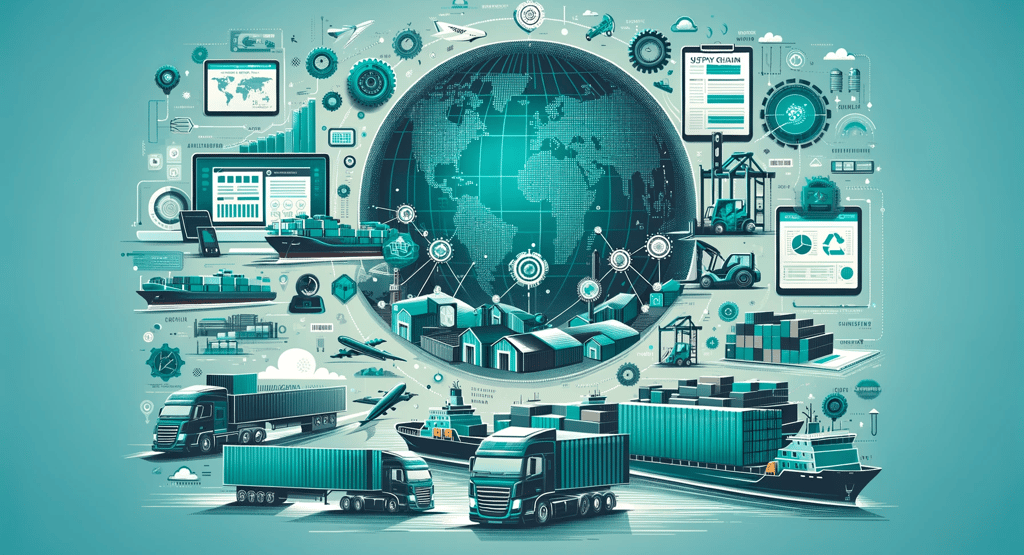Overview of Supply Chain Concepts
What is a supply chain? This simple guide explains the 4 key components, the main functions, and the challenges of the global supply chains that power our economy.
SUPPLY CHAIN
The Procure 4 Marketing Team
11/20/20233 min read


Quick Answer: What is a Supply Chain?
A supply chain is the entire network involved in creating and delivering a product to a customer. Think of it as the complete journey of an item, from sourcing the raw materials (like metal and sand) to manufacturing the product (like a smartphone), distributing it to stores, and finally, its sale to the end-user. It's the lifeblood of commerce, connecting suppliers, manufacturers, retailers, and customers in a global dance of production and logistics.
What are the 4 Key Components of a Supply Chain?
To understand how a supply chain functions, it's best to track the journey of a product. Let's use a smartphone as our example.
1. Suppliers: The Starting Point
Definition: Suppliers are the entities that source and provide the raw materials needed to create a product.
Smartphone Example: A smartphone's journey begins in mines and processing plants around the world. Suppliers extract and refine materials like:
Metals: Lithium for the battery from South America and aluminum for the body from Australia.
Silicon: The foundation for the phone's microchips, sourced from quartzite.
Glass: The durable screen starts as silica, sourced from sand.
2. Manufacturers: The Transformers
Definition: Manufacturers take the raw materials from suppliers and transform them into finished components and assembled products.
Smartphone Example: The raw materials are shipped to manufacturing hubs. The process includes:
Component Manufacturing: Specialized factories create individual parts like camera lenses, processors, and memory chips.
Assembly: In massive, high-tech plants, skilled technicians and robots piece together hundreds of components to build the final smartphone.
3. Distributors & Retailers: The Connectors
Definition: Distributors and retailers form the network that moves the finished product from the manufacturer to the customer.
Smartphone Example: Once assembled, the smartphones are shipped globally. This involves:
Logistics: A complex network of ships, planes, and trucks moves the phones to regional warehouses.
Distribution: From the warehouses, phones are sent to retailers.
Retail: The phones are stocked in physical stores (like Best Buy) and online marketplaces (like Amazon) where customers can buy them.
4. Customers: The Final Destination
Definition: The customer is the end-user whose purchase drives the entire supply chain. Their feedback and buying behavior influence future production.
Smartphone Example: When you buy and use a smartphone, you complete the chain. Your satisfaction, reviews, and even returns provide crucial feedback that loops back to the manufacturer, influencing the design and supply of the next generation of phones.
What are the Main Functions of Supply Chain Management?
Managing a supply chain involves coordinating several key functions. Let's use a clothing retailer as an example:
Demand Planning: Forecasting how many shirts of a certain style will be in demand to avoid overproducing or understocking.
Sourcing & Procurement: Finding and sourcing the right fabrics and materials from reliable suppliers.
Production: Managing the manufacturing process to turn the fabrics into finished clothing.
Inventory Management: Tracking all fabrics and finished clothes in warehouses to ensure the right products are available at the right time.
Logistics & Distribution: Handling the transportation and warehousing to move clothes from the factory to retail stores or directly to online customers.
What are the Different Types of Supply Chains?
Supply chains vary significantly depending on the product and market:
Global Supply Chains: Complex networks where parts are sourced globally, assembled in another country, and sold worldwide (e.g., the automobile industry).
Local Supply Chains: Simple networks that operate within a small geographic area (e.g., a local farm supplying produce to nearby restaurants).
Product-Oriented Supply Chains: Focused on creating and delivering tangible goods (e.g., electronics, furniture).
Service-Oriented Supply Chains: Focused on delivering intangible services (e.g., healthcare, where the "supply chain" involves doctors, nurses, equipment, and medicine to treat a patient).
What are the Biggest Challenges for Modern Supply Chains?
Demand Fluctuations: Sudden trends or economic shifts can cause unpredictable spikes or drops in demand.
Supply Disruptions: Natural disasters, political instability, or pandemics can halt the supply of critical materials.
Logistical Complexity: Managing global transportation, customs, and regulations is incredibly complex.
Sustainability & Ethics: Growing pressure from consumers and regulators to ensure supply chains are environmentally friendly and use ethical labor practices
Frequently Asked questions (FAQ)
Q1: What is the difference between a supply chain and logistics? A: Logistics is one part of the supply chain. It specifically refers to the movement and storage of goods (e.g., transportation, warehousing). The supply chain is the entire, overarching network that includes logistics, as well as procurement, manufacturing, and customer feedback.
Q2: What does 'supply chain resilience' mean? A: Resilience is a supply chain's ability to withstand and recover from disruptions. A resilient supply chain might have multiple suppliers for key materials or backup transportation routes, so a problem in one area doesn't shut down the entire operation.
Q3: Why is a "just-in-time" (JIT) supply chain risky? A: JIT is a strategy where materials arrive just as they are needed for production to minimize storage costs. It is highly efficient but very risky. A single delay in shipping or a problem with one supplier can halt the entire production line because there is no backup inventory.

